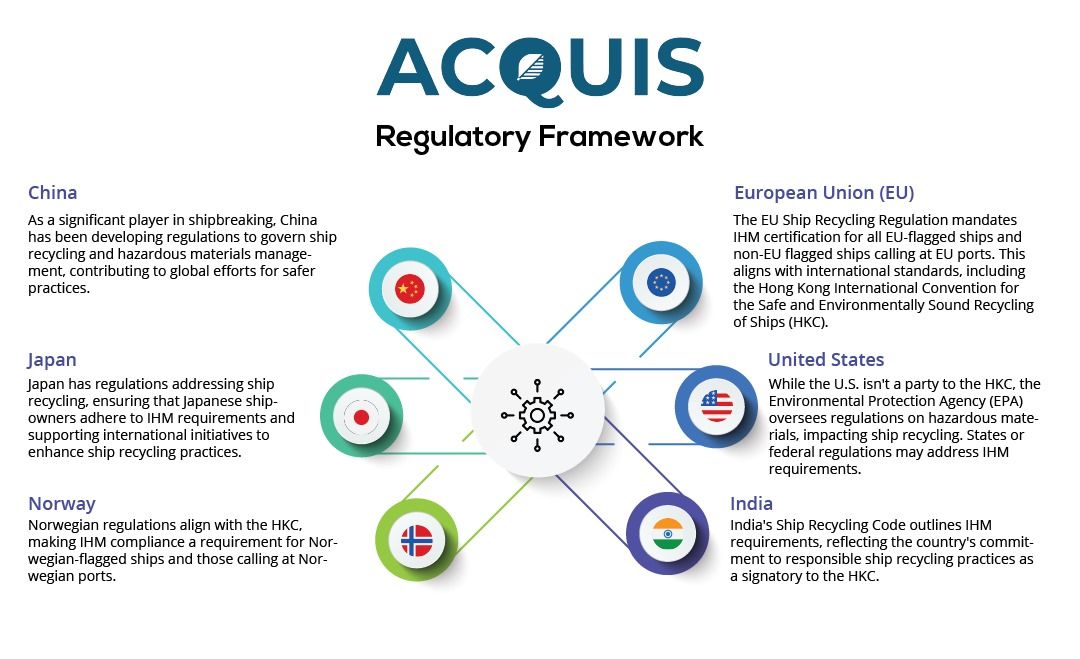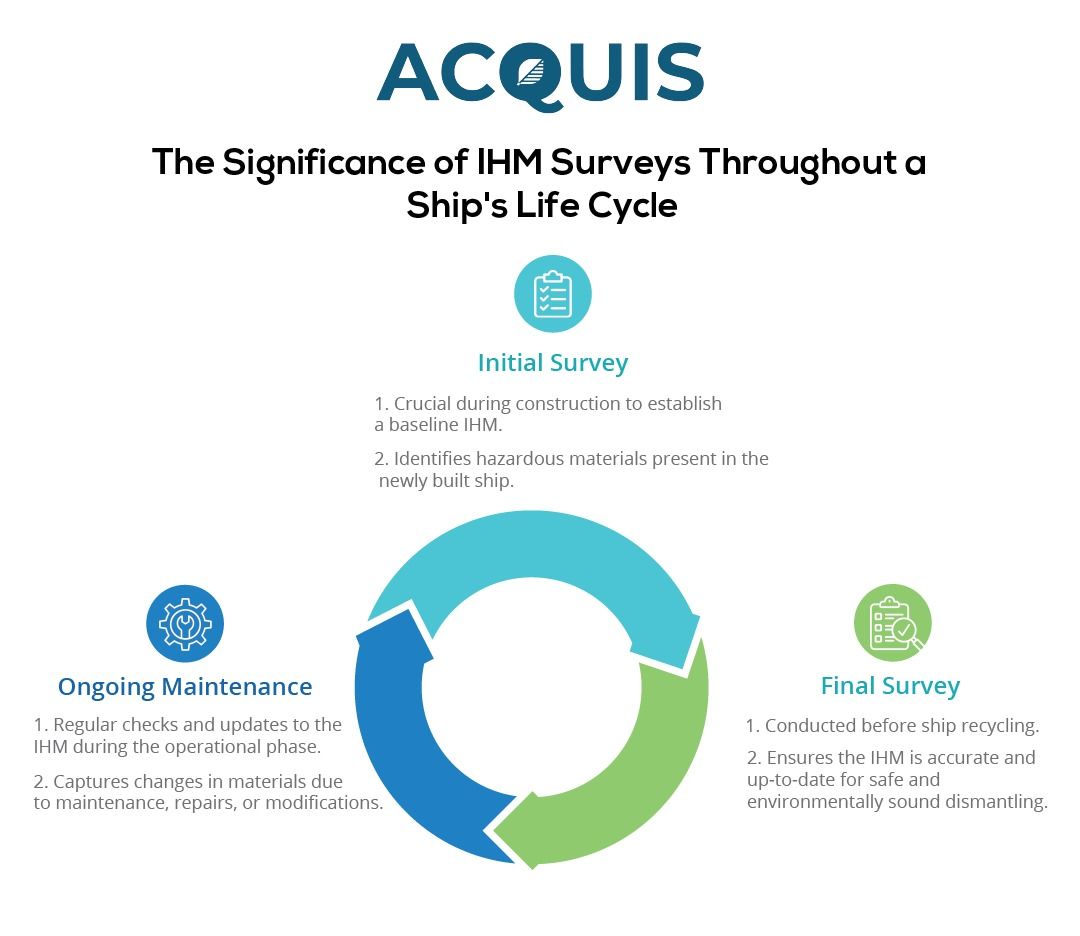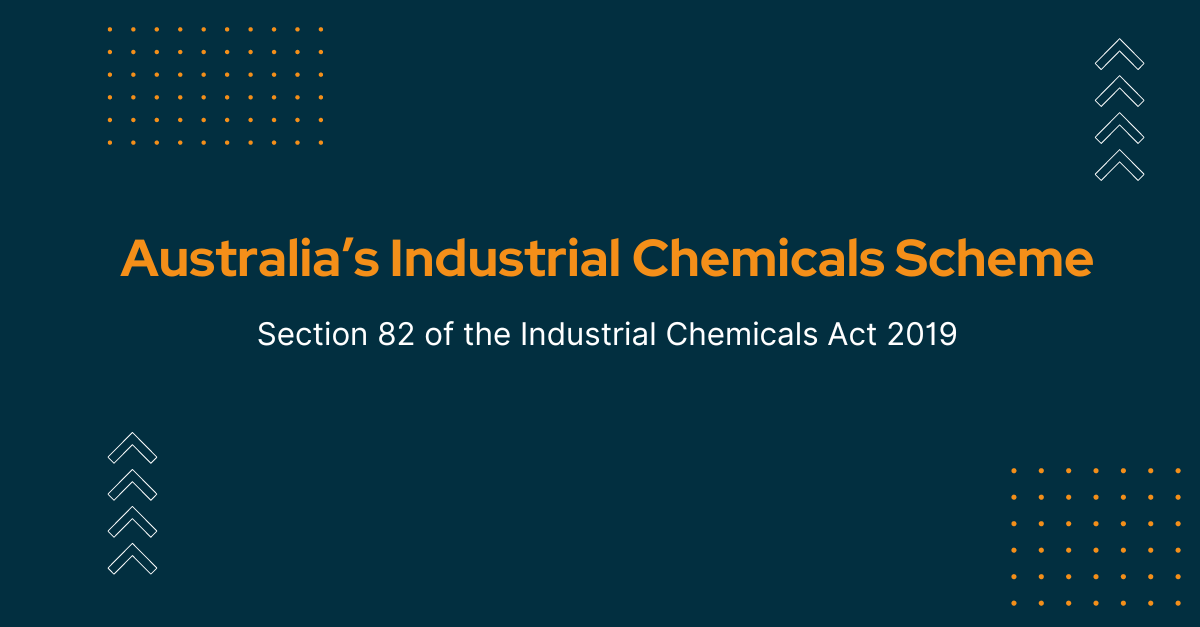The Inventory of Hazardous Materials (IHM) is a crucial component in the maritime industry, particularly in ensuring the safe and environmentally sound recycling of ships.
This inventory helps shipowners, recyclers, and regulatory authorities manage the risks associated with hazardous materials and promote environmentally responsible ship recycling practices.
What is IHM?
Introduction to the IHM and its significance in the maritime sector
The Inventory of Hazardous Materials (IHM) is a comprehensive document that identifies and lists the hazardous materials present in a ship's structure and equipment. This inventory is crucial for ensuring the safe and environmentally responsible management of ships throughout their lifecycle, from construction to operation and ultimately to recycling. The IHM is particularly significant in the context of ship recycling, aiming to minimize the adverse impact of hazardous materials on human health and the environment.
IHM stands for Inventory of Hazardous Materials, and it plays a crucial role in the maritime sector. It is a requirement under the International Maritime Organization's (IMO) Hong Kong International Convention for the Safe and Environmentally Sound Recycling of Ships.
The significance of IHM in the maritime sector lies in its contribution to the safety of both the crew and the environment. By identifying and documenting hazardous materials on board, IHM helps in the proper management, handling, and disposal of these materials during a ship's lifecycle. This is particularly important during ship recycling, as it ensures environmentally sound practices and the protection of workers involved in the dismantling process.
IHM implementation also aids in compliance with international regulations, promoting sustainable and responsible ship recycling practices. It enhances transparency in the maritime industry, improves safety standards, and reduces the environmental impact of ship operations and recycling. Overall, IHM is a critical tool for ensuring the safety, health, and environmental sustainability of the maritime sector.
The importance of managing hazardous materials for safety and environmental reasons:
The proper management of hazardous materials is essential for safeguarding human health, preventing environmental degradation, complying with regulations, and promoting sustainable and responsible business practices. Managing hazardous materials is of paramount importance for both safety and environmental reasons in various industries, including maritime.
Below are key points emphasizing this importance:
Human Safety:
-
Occupational Health: Exposure to hazardous materials poses significant risks to the health and safety of workers. Proper management ensures that individuals working with or around these materials are adequately protected.
-
Emergency Response: Knowing and managing hazardous materials is crucial for effective emergency response. In the event of accidents or spills, quick and informed actions can minimize harm to personnel.
Environmental Protection:
- Preventing Pollution: Improper disposal or handling of hazardous materials can lead to pollution of air, water, and soil. This pollution can have severe and long-lasting effects on ecosystems and human populations.
- Ecosystem Impact: Some hazardous materials can be particularly harmful to aquatic life and terrestrial ecosystems. Managing their use and disposal helps protect biodiversity and ecosystem health.
Legal Compliance:
- Regulatory Requirements: Many industries, including maritime, are subject to strict regulations governing the use, transportation, and disposal of hazardous materials. Compliance with these regulations is not only a legal obligation but also ensures responsible and ethical business practices.
Public Health:
- Community Impact: Improper management of hazardous materials can affect communities living near industrial areas, transportation routes, or disposal sites. Minimizing exposure is essential to protect the health and well-being of the broader population.
Long-Term Liabilities:
- Liability Reduction: Proactive management of hazardous materials reduces the risk of accidents, spills, and environmental damage. This, in turn, helps mitigate long-term legal and financial liabilities that may arise from such incidents.
Sustainable Practices:
- Corporate Responsibility: Managing hazardous materials is a key aspect of corporate social responsibility. Embracing sustainable practices in material use, handling, and disposal aligns with global efforts towards environmental sustainability.
Global Cooperation:
- International Standards: In a globalized economy, adherence to international standards for managing hazardous materials fosters cooperation and ensures a unified approach to environmental and safety challenges.
Regulatory Framework:
The Hong Kong International Convention for the Safe and Environmentally Sound Recycling of Ships (HKC) is an international regulatory framework established by the International Maritime Organization (IMO). It aims to ensure the safe and environmentally responsible recycling of ships by mandating the development of Ship Recycling Plans (SRPs) and Inventories of Hazardous Materials (IHMs). The convention covers all ships and sets standards for ship recycling facilities, emphasizing worker safety and environmental protection. It entered into force on December 24, 2018, and compliance is crucial for shipowners, recycling facilities, and flag and recycling states to promote sustainable and safe ship recycling practices.
In the realm of maritime regulations, the Inventory of Hazardous Materials (IHM) plays a crucial role in ensuring both safety and environmental responsibility. Several national and regional regulations have been established to address IHM requirements. Regulations may evolve, so staying updated on the specific IHM requirements of the operating region is crucial for shipowners and stakeholders in the maritime industry. These regulations collectively contribute to safer and more environmentally responsible ship recycling practices on a global scale.
Here are some notable examples:

-
European Union (EU): The EU Ship Recycling Regulation mandates IHM certification for all EU-flagged ships and non-EU flagged ships calling at EU ports. This aligns with international standards, including the Hong Kong International Convention for the Safe and Environmentally Sound Recycling of Ships (HKC).
-
United States: While the U.S. isn't a party to the HKC, the Environmental Protection Agency (EPA) oversees regulations on hazardous materials, impacting ship recycling. States or federal regulations may address IHM requirements.
-
India: India's Ship Recycling Code outlines IHM requirements, reflecting the country's commitment to responsible ship recycling practices as a signatory to the HKC.
-
China: As a significant player in shipbreaking, China has been developing regulations to govern ship recycling and hazardous materials management, contributing to global efforts for safer practices.
-
Japan: Japan has regulations addressing ship recycling, ensuring that Japanese shipowners adhere to IHM requirements and supporting international initiatives to enhance ship recycling practices.
-
Norway: Norwegian regulations align with the HKC, making IHM compliance a requirement for Norwegian-flagged ships and those calling at Norwegian ports.
Scope of Inventory of Hazardous Materials (IHM)
The Inventory of Hazardous Materials (IHM) is a comprehensive document crucial for maritime safety and environmental responsibility. It identifies and documents hazardous materials throughout a ship's structure and equipment. This includes substances like asbestos, PCBs, heavy metals, and other harmful chemicals in structural components, equipment, outfitting materials, insulation, pipes, cables, residues, refrigeration systems, ballast tanks, anti-fouling paints, and potential radioactive materials. The IHM is essential for compliance with international regulations, notably the Hong Kong International Convention for the Safe and Environmentally Sound Recycling of Ships (HKC). It ensures ships are managed and recycled in a way that minimizes risks to health and the environment, emphasizing safety and sustainability in the maritime industry.
The Inventory of Hazardous Material Domains: The Inventory Hazard Management (IHM) list gives ship-specific details about the real hazardous materials that are on board, where they are, and how much of them are there. Regarding the IHM, there are three components. These are:
- Hazardous materials which form part of the structure of the vessel and its equipment
- Hazardous wastes generated as part of the vessel’s operations
- Hazardous stores
Life Cycle Phases:
During the building, operating, and recycling stages of a ship's life cycle, the Inventory of Hazardous Materials (IHM) is essential. The following lists the IHM requirements for each phase:

Construction Phase:
- Initial IHM Survey:
- An initial IHM survey is carried out during the construction phase to identify and record any hazardous materials used in the equipment and structure of the ship.
- Pay attention to substances that could be harmful, such as asbestos and PCBs.
Operational Phase:
- Ongoing Maintenance:
- Regular updates to the IHM are necessary during the operational phase.
- Document any changes or additions to hazardous materials due to maintenance, repairs, or modifications.
- Ensure that the IHM remains an accurate and up-to-date reference for onboard hazardous materials.
- Ship Recycling Plan (SRP):
- Develop and maintain the Ship Recycling Plan (SRP) during the operational phase. The SRP outlines procedures for the safe and environmentally sound recycling of the ship.
Recycling Phase:
- Final IHM Survey:
- Conduct a final IHM survey before ship recycling commences.
- Reassess and update the IHM to reflect the ship's current status, accounting for any changes during its operational life.
- Ensure that the IHM provides a comprehensive and accurate inventory of hazardous materials to guide safe and environmentally responsible recycling practices.
- Handover of IHM and SRP:
- Provide the IHM and SRP to the recycling facility to facilitate the proper handling of hazardous materials.
- Ensure that the recycling facility has access to the necessary information for safe and compliant dismantling.
- Monitoring and Compliance:
- Monitor the recycling process to ensure compliance with the IHM and SRP.
- Verify that hazardous materials are being managed and disposed of according to regulatory requirements.
The Significance of IHM Surveys Throughout a Ship's Life Cycle
By emphasizing the importance of initial, ongoing, and final surveys, the IHM becomes a dynamic and reliable tool for managing hazardous materials throughout a ship's life cycle. This approach aligns with international regulations, such as the Hong Kong International Convention for the Safe and Environmentally Sound Recycling of Ships (HKC).

IHM Certificate
In the realm of maritime regulations, two primary certificates stand as guardians of safety, environmental responsibility, and compliance—The International Certificate on Inventory of Hazardous Materials and the International Ready for Recycling Certificate. These certificates, essential for ships of 500 gross tonnage and above, are indispensable markers of a vessel's commitment to managing hazardous materials and facilitating safe recycling practices.
The certificates are followed:
- International Certificate on Inventory of Hazardous Materials (IHM):
This certificate attests that the ship has undergone a thorough IHM assessment, identifying and documenting hazardous materials throughout its structure and equipment. It signifies compliance with international regulations, emphasizing safety for crew members during the operational phase.
- International Ready for Recycling Certificate:
This certificate is a forward-looking document, confirming that the ship is prepared for safe and environmentally sound recycling at the end of its operational life. It underscores the ship's adherence to responsible recycling practices, as outlined in the Ship Recycling Plan (SRP).
- Inspections and Compliance Verification:
Inspections of ships of 500 gross tonnage and above primarily focus on verifying the possession of these two essential certificates. A ship lacking either certificate prompts a detailed inspection, guided by IMO guidelines. This meticulous scrutiny ensures that vessels meet the stringent standards set by international regulations, reflecting a commitment to maritime safety and environmental stewardship. In the absence of the required certificates, inspections follow the guidelines provided by the International Maritime Organization (IMO). These guidelines serve as a comprehensive framework, guiding inspectors through a detailed assessment of the ship's hazardous material management and recycling readiness. Such inspections are critical to maintaining the integrity of international standards and fostering a culture of compliance within the maritime industry.
Sailing Toward Sustainability: The Crucial Link Between IHM and Ship Recycling Plans (SRP)
The Ship Recycling Plan (SRP) emerges as a crucial blueprint, charting the course for dismantling vessels in a manner that safeguards both human health and the environment. This plan draws extensively from the vital information encapsulated in the Inventory of Hazardous Materials (IHM), creating a seamless connection between a ship's operational life and its final voyage to the recycling yard. Utilizing IHM for SRP Creation:
- Identification of Hazardous Materials: The IHM serves as the foundational document, identifying hazardous materials embedded within a ship's structure, equipment, and systems.
Specific materials, such as asbestos, PCBs, heavy metals, and others flagged in the IHM, are crucial elements considered in the SRP creation.
- Comprehensive Inventory: IHM provides a comprehensive inventory of materials, detailing their locations and quantities on board the ship.
This information guides the development of the SRP, ensuring that all hazardous materials are accounted for and properly managed during the recycling process.
- Risk Assessment: The IHM aids in assessing the risks associated with various materials, allowing the SRP to outline specific procedures for the safe dismantling and disposal of hazardous components.
Risk mitigation measures, based on IHM data, are integrated into the SRP to protect both workers and the environment
The Ship Recycling Plan (SRP) holds significant importance in ensuring environmentally responsible ship recycling practices:
- Environmental Responsibility:
Practices Establishment: The SRP sets guidelines for environmentally responsible ship recycling, emphasizing the correct handling and disposal of hazardous materials.
International Standards Adherence: It ensures that recycling facilities conform to global standards, minimizing the ecological impact of the dismantling process.
- Worker Safety:
Occupational Health Mitigation: By using IHM data, the SRP addresses health risks associated with hazardous materials during ship recycling.
Safe Working Environment: It outlines proper procedures for worker protection, training, and equipment use, fostering a secure working environment.
- Compliance with International Standards:
Alignment with Regulations: The SRP aligns with international regulations, including the Hong Kong International Convention for the Safe and Environmentally Sound Recycling of Ships (HKC).
Commitment to Standards: Its implementation signifies a commitment to upholding global standards, ensuring sustainable and safe ship recycling practices worldwide.
The role of MEPC.269(68) for IHM development :
MEPC.269(68) plays a crucial role in guiding the development of the Inventory of Hazardous Materials (IHM) within the maritime industry. Serving as a beacon of standardization, this resolution establishes clear and consistent guidelines for IHM creation, ensuring a systematic approach across diverse maritime contexts. MEPC.269(68), which specifies content requirements, outlines the identification and documentation of hazardous materials that cover the ship's equipment, systems, and structure. Its importance is felt all the way through the IHM lifecycle, providing thorough direction from the first survey conducted during construction to updates during use to the last survey conducted prior to recycling. The resolution also takes a firm stand in defining and assigning roles to important parties, promoting smooth adherence to IHM regulations by shipowners, operators, and recycling facilities.
MEPC.269(68) harmonizes the development of IHM with international conventions and standards, establishing a uniform framework that covers a range of ship types, such as cargo ships, passenger ships, and offshore platforms. It prioritizes safety and environmental protection, emphasizing safe practices and the proper disposal of hazardous materials. Furthermore, by including provisions for updates and amendments, MEPC.269(68) ensures that its guidelines remain current, reflecting the dynamic nature of industry practices, technological advancements, and regulatory changes. MEPC.269(68) is essentially a comprehensive guide that steers the maritime sector toward standardized, lifecycle-oriented, and safety-conscious hazardous material management practices.
Global Status of IHM Implementation:
The global implementation of Inventory of Hazardous Materials (IHM) regulations has witnessed significant strides in enhancing the maritime industry's commitment to safe and environmentally responsible practices. The International Maritime Organization (IMO) has played a pivotal role by issuing guidelines, notably MEPC.269(68), fostering a standardized and systematic approach to IHM development. Shipowners and operators, recognizing the importance of IHM, have embraced these guidelines, with a focus on integrating them into new builds and considering retrofitting existing vessels. However, challenges persist, including varying levels of awareness and the need for effective enforcement mechanisms. On the international front, the progress toward the entry into force of the Hong Kong International Convention for the Safe and Environmentally Sound Recycling of Ships (HKC) has been a topic of global attention.
Although the HKC has not yet come into effect, positive momentum is evident, with increasing support from various countries. Some regions have taken the initiative to align their legislation with the HKC's requirements, signaling a commitment to international standards for responsible ship recycling. While challenges remain, these developments underscore a growing dedication to fostering safety, sustainability, and environmental protection in the maritime sector.
How countries are adopting and enforcing IHM regulations ?
The global implementation of Inventory of Hazardous Materials (IHM) regulations presents a varied landscape marked by diverse approaches to adoption and enforcement among individual countries. The integration of IHM requirements into national maritime legislation is a testament to the widespread recognition of IHM's critical role in promoting safe and environmentally responsible ship recycling practices. This integration not only provides a robust legal foundation for compliance but also underscores a collective commitment to upholding global standards, exemplified by the ratification of international conventions like the Hong Kong International Convention for the Safe and Environmentally Sound Recycling of Ships (HKC). The instrumental role of Port State Control inspections in enforcing IHM regulations highlights the active scrutiny applied by countries to ensure adherence. Collaborative efforts at regional and international levels, coupled with capacity-building initiatives and awareness programs, contribute significantly to a harmonized approach to IHM implementation. The tailored adaptation of IHM regulations by countries, considering their unique maritime contexts, further reflects a nuanced and practical enforcement strategy. Penalties for non-compliance serve as a clear reinforcement of the importance of IHM adherence in maintaining industry standards.
Conclusion:
The Inventory of Hazardous Materials (IHM) is pivotal for maritime safety and environmental responsibility, ensuring the secure management of hazardous materials from a ship's construction to recycling. Aligned with international regulations, especially the Hong Kong International Convention (HKC), and supported by MEPC.269(68), IHM surveys and Ship Recycling Plans (SRP) play a dynamic role in a ship's life cycle, promoting safety, adherence to standards, and sustainable practices. Certificates like the International Certificate on Inventory of Hazardous Materials validate compliance, while global progress is evident despite challenges. Individual countries' adoption reflects a diverse landscape, emphasizing collaboration and enforcement through Port State Control inspections. In essence, IHM is a vital tool for safeguarding lives, protecting the environment, and ensuring the maritime sector's sustainability.
Speak to Our Compliance Experts
Share
ENVIRONMENTAL COMPLIANCE
- RoHS
- SCIP (WFD)
- REACH
- California Proposition 65
- Material Disclosure (FMD)
- PFAS
- TSCA PBT
- EU POPs
- EU MDR & IVDR
- ELV (GADSL)
- Others
- Extended Producer Responsibility (EPR)
INTEGRATION SUPPORT
WE ARE GLOBAL
USA
6705 Ridgedale CT, Glen Allen, VA 23059
+1.757.801.2760
info@aquiscompliance.com
India
#9/2, Hennur Bagalur Main Road, Bengaluru - 560077
+91 789 238 1827
info@aquiscompliance.com



